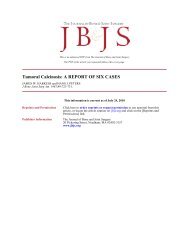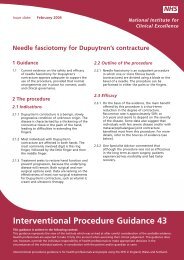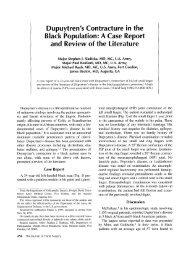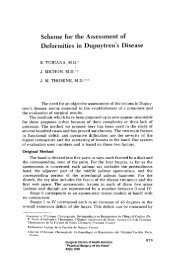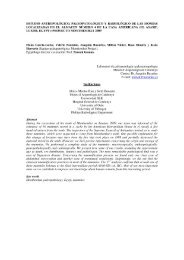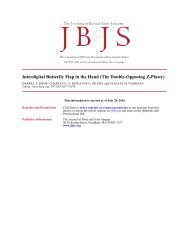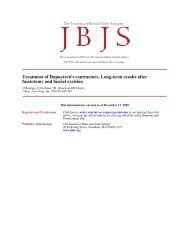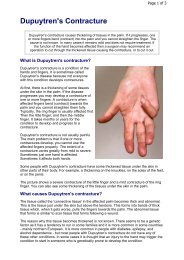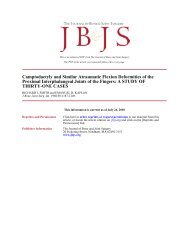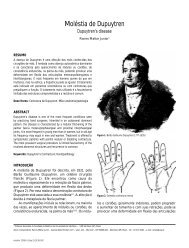The Hand - Dupuytren Foundation
The Hand - Dupuytren Foundation
The Hand - Dupuytren Foundation
Create successful ePaper yourself
Turn your PDF publications into a flip-book with our unique Google optimized e-Paper software.
<strong>The</strong> <strong>Hand</strong><br />
http://jhs.sagepub.com/<br />
<strong>Dupuytren</strong>'s Contracture−−<strong>The</strong> Role of Fasciotomy<br />
J. COLVILLE<br />
<strong>Hand</strong> 1983 os-15: 162<br />
DOI: 10.1016/S0072-968X(83)80008-4<br />
<strong>The</strong> online version of this article can be found at:<br />
http://jhs.sagepub.com/content/os-15/2/162<br />
Published by:<br />
http://www.sagepublications.com<br />
On behalf of:<br />
British Society for Surgery of the <strong>Hand</strong><br />
Federation of the European Societies for Surgery of the <strong>Hand</strong><br />
Additional services and information for <strong>The</strong> <strong>Hand</strong> can be found at:<br />
Email Alerts: http://jhs.sagepub.com/cgi/alerts<br />
Subscriptions: http://jhs.sagepub.com/subscriptions<br />
Reprints: http://www.sagepub.com/journalsReprints.nav<br />
Permissions: http://www.sagepub.com/journalsPermissions.nav<br />
Citations: http://jhs.sagepub.com/content/os-15/2/162.refs.html<br />
>> Version of Record - Jun 1, 1983<br />
What is This<br />
Downloaded from jhs.sagepub.com by guest on July 19, 2012
<strong>Dupuytren</strong>'s Contracture-- <strong>The</strong> Role of Fasciotomy<br />
J. Colville<br />
DUPUYTREN'S CONTRACTURE--THE ROLE OF FASCIOTOMY<br />
J. COLVILLE, Belfast<br />
SUMMARY<br />
This paper summarises the results obtained in 95 patients treated by<br />
fasciotomy, defines the indications for this procedure and describes the operative<br />
technique. During a period of seven years a total of 95 patients with 137fingers<br />
affected by <strong>Dupuytren</strong>'s' Contracture have been treated by fasciotomy. <strong>The</strong><br />
minimum follow-up is two years. <strong>The</strong> oldest patient was 79 years and no patient<br />
younger that 50 years was accepted for this form of treatment.<br />
With lengthening active life span increasing numbers of elderly people now<br />
present for correction of <strong>Dupuytren</strong>'s contracture, In many cases it is interference<br />
with a sport or hobby which stimulates this. After treating a number of these<br />
patients by fasciotomy alone it became apparent that in a proportion of cases the<br />
results were outstandingly good. It seems reasonable to offer suitable patients this<br />
simple procedure which does not involve risk and which causes minimal<br />
inconvenience.<br />
INDICATIONS FOR FASCIOTOMY<br />
<strong>The</strong> following factors are considered important in deciding whether or not this<br />
line of treatment should be adopted:--<br />
Type of band: This must be disposed in a linear,direction and preferably cord=like.<br />
Any lateral extensions such as seen in the plaque type of <strong>Dupuytren</strong>'s involvement<br />
found in epileptics or more common in the younger age group is a definite contraindication.<br />
Extensions from the main band to the deeper structures of the palm<br />
prevent bow-stringing of the band and the absence of bow-stringing is therefore<br />
considered a contra-indication. Conversely the appearance of a well-marked bowstringing<br />
indicates an absence of deep nattachments and is a favourable indication.<br />
Overlying skin: Ideally the skin should be separated from the band by subcutaneous<br />
fat which is not affected by the <strong>Dupuytren</strong>'s process. Extensive attachment between<br />
the skin and the underlying band prevents an effective fasciotomy and contraindicates<br />
the procedure. A limited degree of adhesion between the band and the<br />
overlying skin can be corrected at the time of the fasciotomy and does not contraindicate<br />
the procedure. Occasionally a band may be suitable for fasciotomy at the<br />
palmar level but because of skin adhesion in the proximal phalanx it may not be<br />
suitable at this level.<br />
Age or infirmity: Because of the progressive nature of the disease our general policy<br />
is to perform fasciectomy on those under the age of sixty years unless the<br />
<strong>Dupuytren</strong>'s bands are particularly ideal for fasciotomy. <strong>Dupuytren</strong>'s contracture in<br />
young adults and epileptics must be dealt with by fasciectomy. Some very elderly<br />
patients had fasciotomy in spite of having a type of <strong>Dupuytren</strong>'s band that was not<br />
really suitable for such a procedure. This was relatively indicated in view of the<br />
simplicity of the procedure and the expectation of modest benefit.<br />
J. Colville, F.R.C.S. <strong>The</strong> Ulster Hospital, Dundonald, Belfast, Northern Ireland<br />
162 <strong>The</strong> <strong>Hand</strong>-- Volume 15 No. 2 1983<br />
Downloaded from jhs.sagepub.com by guest on July 19, 2012
<strong>Dupuytren</strong>'s Contracture-- <strong>The</strong> Role of Fasciotomy<br />
J. Colville<br />
Fig. 1. Enlarged view of modified No. 11 blade.<br />
Preliminary to Fasciectomy: In some hands, with severe contracture, and where<br />
there is a shortage of palmar skin there is some advantage in a preliminary<br />
fasciotomy to stretch the skin in preparation for a definitive removal of the<br />
<strong>Dupuytren</strong>'s tissue by fasciectomy. It should be stressed that the fasciectomy<br />
performed after such a fasciotomy is somewhat more difficult although the skin<br />
closure is facilitated. This was done in three patients not included in the series.<br />
OPERATIVE TECHNIQUE<br />
<strong>The</strong> operation is carried out as an out-patient procedure. A tourniquet is not<br />
necessary. <strong>The</strong> skin in the area of the hand to be released is infiltrated with 2 per cent<br />
plain Lignocaine. Three areas of release are usually employed. <strong>The</strong> first is proximal<br />
to the distal palm crease, the second proximal to the web crease and the third<br />
proximal to the proximal interphalangeal joint crease. A number 11 surgical blade<br />
which has been modified as shown on the accompanying diagram is inserted into the<br />
skin lateral to the band. <strong>The</strong> blade is held horizontally and by a series of sweeping<br />
arcs the skin distal to the proposed point of fasciotomy is freed from the underlying<br />
band. <strong>The</strong>re is no point in freeing the skin proximal to the point of the fasciotomy.<br />
In some instances the skin has corrugated over the contracted bands and this is a<br />
particularly favourable situation since the corrugations open out to provide an extra<br />
supply of skin when the band is divided. At each level of division, having satisfied<br />
oneself that there is sufficient mobility of the overlying skin, the fasciotomy is then<br />
undertaken. <strong>The</strong> blade is turned vertically and gently applied to the band which is<br />
held in tension. <strong>The</strong> sense of cutting through this band is more a scratching process<br />
rather than a cutting process and the band tends to cut itself against the lightly<br />
applied point of the blade rather than a purposeful incision movement of the blade.<br />
A gratifying snapping can be felt and sometimes heard when the band has been<br />
successfully divided and the retreat of the distal end of the divided band under the<br />
freed skin can sometimes be observed. <strong>The</strong> procedure of freeing the skin and<br />
division of the <strong>Dupuytren</strong>'s band is repeated at the distal palm crease level and then<br />
if necessary at the proximal phalangeal level. <strong>The</strong> finger is extended until the skin<br />
tension is the limiting factor. Occasionally, where the skin has been locally adherent<br />
to the band and has been separated it may rupture and a small transverse wound so<br />
caused may, under tension, become longitudinally orientated producing what could<br />
be described as a 'Diamond-plasty'. A single transverse suture across the diamondplasty<br />
may be used to close this small wound although this is not essential. Various<br />
types of Fasciotomes have been tried but I have reverted to the modified Swann<br />
Morton No. 11 Blade. This has the advantage of rigidity and the operator retains a<br />
feeling of contact with the cutting part of the blade. This contact with the cutting<br />
<strong>The</strong> <strong>Hand</strong>-- Volume 15 No. 2 1983 163<br />
Downloaded from jhs.sagepub.com by guest on July 19, 2012
<strong>Dupuytren</strong>'s Contracture-- <strong>The</strong> Role of Fasciotomy<br />
J. Colville<br />
end of the instrument is less well appreciated when using a more flexible and slender<br />
fasciatome. <strong>The</strong> orientation of the cutting edge can be a problem if there is nothing<br />
to indicate this on the handle, but this is not so when using the conventional scalpel<br />
handle and No. 11 Blade.<br />
Following the release of the contracture the hand is dressed conventionally and<br />
immobilised in a plaster-of-Paris gutter slab retaining as much extension<br />
improvement as possible. <strong>The</strong> patient is next seen one week later when the dressings<br />
are removed and the wound is invariably dry and healed. A fresh lightly padded<br />
plaster-of-Paris slab is again re-made and applied snugly to the bare arm and<br />
forearm with the fingers in as much extension as possible. When this has become<br />
sufficiently rigid it is removed and carefully placed in a bag with one or two crepe<br />
bandages. <strong>The</strong> patient does not require any further dressing and is given the new<br />
splint to take home carefully and is instructed to bandage this to his hand and<br />
forearm each night before retiring. <strong>The</strong> patient is also instructed to report if either<br />
the plaster becomes damaged or if further extension is achieved requiring a more<br />
closely fitting splint. One patient, a female with 120 ~ contracture which had<br />
improved to a 45 ~ contracture position reported three weeks later with her finger<br />
almost completely extended. Splintage is normally discarded after a period of three<br />
months. Invariably the patient can immediately start using the hand after the plaster<br />
has been removed at the first post-operative attendance. <strong>The</strong>re has rarely been any<br />
cases of hand swelling or other cause for morbidity.<br />
In this series and in all other patients who have had fasciotomy performed there<br />
has not been any instance of haematoma or infection and nor has there been<br />
evidence of permanent damage to digital nerves. Some patients mention tingling of<br />
the fingers for a number of weeks presumably due to stretching of the digital nerves,<br />
but this invariably recovers.<br />
RESULTS<br />
TABLE 1<br />
AVERAGE OF ALL CONTRACTURES IN 137 FINGERS EXPRESSED AS DEGREES OF<br />
EXTENSION DEFICIT FROM THE PLANE OF THE METACARPAL<br />
1tamed.<br />
3 Years<br />
Pre-op Post-op 3 months 6months 1year (For 107Fingers)<br />
102 ~ 45 ~ 31 ~ 50 ~ 56 ~ 75 ~<br />
<strong>The</strong> improvement of an average of 14 ~ from the immediate post-operative<br />
improvement to the three month position is due to the fact that in some cases there was<br />
quite a marked improvement obtained by the splintage which was regarded as an<br />
essential adjunct to operation. <strong>The</strong> three year follow-up was chosen since beyond this<br />
period many elderly patients did not wish to attend. <strong>The</strong> results in this column appear<br />
somewhat disappointing but this is exaggerated because those whose hands were<br />
satisfactory tended not to re-attend and those whose hands were less satisfactory were<br />
more inclined to report for further follow-up.<br />
164 <strong>The</strong> <strong>Hand</strong>-- Volume 15 No. 2 1983<br />
Downloaded from jhs.sagepub.com by guest on July 19, 2012
<strong>Dupuytren</strong>'s Contracture-- <strong>The</strong> Role of Fasciotomy<br />
J. Colville<br />
TABLE 2<br />
TWENTY CASES WITH THE BEST RESULTS (29 digits)<br />
Average Average Average Average Average Average<br />
Pre-op Pos~op 3months 6months 1 year 3 years<br />
104 ~ 26 ~ 23 ~ 23 ~ 30 ~ 32 ~<br />
Nine of the total had less than 20 ~ extension deficit three years after their<br />
fasciotomy. <strong>The</strong> twenty cases with the worse results had all relapsed within one year.<br />
DISCUSSION<br />
It is rather surprising to find that there are only a few published references to<br />
fasciotomy when one considers the numerous publications on fasciectomy. In<br />
discussion with colleagues I get the impression that many hand surgeons<br />
occasionally perform a fasciotomy but there does not seem to be any attempt to<br />
establish the indications for this procedure. <strong>The</strong>re is undoubtedly a place for such a<br />
procedure in selected patients and a permanent recovery of effective extension is<br />
expected.<br />
Since all patients were warned at first consultation that the procedure might<br />
have to be repeated within two or three years there was no disappointment in those<br />
who required a repetition of the fasciotomy after such a period, although where the<br />
indications were ideal this was seldom required. <strong>The</strong>re was also a number of patients<br />
in this series whose indications for fasciotomy were not ideal but these patients were<br />
accepted for this procedure because of concomitant medical or surgical problems<br />
that contra-indicated fasciectomy. In this category there were three patients with an<br />
uncertain prognosis due to neoplasm elsewhere and there was also a number of<br />
patients particularly in the more elderly group, who had heard of such a procedure<br />
and who were willing to submit themselves to a minor operation only, in spite of<br />
having been warned that, in their particular case, this might not be very successful.<br />
Recurrence of the contracture is an accepted penalty for such a simple<br />
operation. <strong>The</strong> repeat fasciotomy is not so satisfactorily performed but nevertheless<br />
has a useful place in treatment and certainly the patients accept this more readily<br />
than the prospect of a more complicated operation requiring hospitalisation.<br />
It is paradoxical that the more contracted the finger, the shorter the<br />
<strong>Dupuytren</strong>'s band and the smaller the block of <strong>Dupuytren</strong>'s tissue causing the<br />
contracture. Once this band has been divided and its attachments freed, it is not<br />
difficult to envisage an excursion of 2cm, distal progression of the divided band. A<br />
student of tendon mechanics in the hand will realise that this represents about 180 ~<br />
of finger joints range.<br />
Historically Sir Astley Cooper (1823) and <strong>Dupuytren</strong> (1832) also recommended<br />
fasciotomy and at a later date Adams in 1878 and McCready 1890 referred to this as<br />
a useful procedure. Since that time there have been incidental references to the<br />
procedure and most authors, in dealing with the subject of <strong>Dupuytren</strong>'s contracture<br />
have paid lip service to the place of fasciotomy. Apart from suggesting that this is a<br />
reasonable procedure in the elderly there has not been any attempt to define its<br />
precise indications.<br />
Luck (1959) in his article on fasciotomy advocated removal of the nodule as<br />
well as division of the band as an essential part of the operation. I was not aware of<br />
his recommendations until my own results were apparent and since these seemed<br />
<strong>The</strong> <strong>Hand</strong>-- Volume 15 No. 2 1983 165<br />
Downloaded from jhs.sagepub.com by guest on July 19, 2012
<strong>Dupuytren</strong>'s Contracture-- <strong>The</strong> Role of Fasciotomy<br />
J. Colville<br />
satisfactory without nodule excision, I could not therefore recommend converting<br />
what was a very simple procedure into one that would have been much more<br />
complicated. Luck also advised that the subcutaneous fasciotomy should be restricted<br />
to the palm but I have no hesitation in advocating fasciotomy in the proximal phalanx<br />
pro vided the band is well de fin ed and bo w-stringing. Th ere are many instances in which<br />
fasciotomy is contra-indicated in the proximal phalanx and I can well appreciate<br />
Tubiana's (1974) recommendation that fasciotomy is contra-indicated at this level.<br />
Gonzalez (1974) emphasised the value of the inter-position of a full thickness skin<br />
graft as a means of preventing the divided ends of the <strong>Dupuytren</strong>'s band from becoming<br />
reattached. However, I would suggest that where the band is reasonably surrounded by<br />
uninvolved fat, if the separated ends can be maintained in this position for a reasonable<br />
time this fat will serve to separate permanently the ends of the band provided no other<br />
unyielding tissue, such as scar or further <strong>Dupuytren</strong>'s tissue, re-approximates these<br />
ends.<br />
I have not personally used the enzymic fasciotomy first described by Bassot (1965)<br />
and later by Hueston (1974). I doubt if this can improve on what would be more simply<br />
achieved by subcutaneous fasciotomy, in the manner described in this article. It is my<br />
opinion that about 10~ of patients develop a type of <strong>Dupuytren</strong>'s tissue which<br />
progresses to a situation where the contracting band is very similar to a tendon. If this is<br />
found or if a similar situation can be created and if there is soft uninvolved fat available<br />
to fill the gap between the distracted ends of the divided <strong>Dupuytren</strong>'s band and if these<br />
can be kept separate for a sufficient length of time there is a good prospect of a<br />
permanent and useful recovery of extension.<br />
CONCLUSION<br />
I am confident that there is a limited place for fasciotomy to supplement the well<br />
established procedure of fasciectomy in the treatment of <strong>Dupuytren</strong>'s disease of the<br />
hand. If the indications for this are met, then there is a reasonable expectation of<br />
recovery of useful extension which, even if not permanent may only require a further<br />
similar treatment after a number of years, If the surgeon is ultra-selective, results as<br />
good as fasciectomy are possible in a small percentage of all cases presenting.<br />
REFERENCES<br />
ADAMS, W. (1878). Contraction of the Fingers (<strong>Dupuytren</strong>'s Contraction) and Its Successful<br />
Treatment by Subcutaneous Divisions of the Palmar Fascia and Immediate Extension.<br />
British Medical Journal 1: 928.<br />
BASSOT, J. (1965). Traitment de la maladie de <strong>Dupuytren</strong> par ex6rbse pharmacodynamique isol6e<br />
ou compl&6e par un temps plastique uniquement cutan6. Lille Chirurgical 20, 38.<br />
COO/~ER, ASTLEY. A Treatise on Dislocations and on Fractures of the Joints. London, Longman,<br />
Hurst, Rees, Orme and Browne, 1823.<br />
DUPUYTREN, GUILLAUME: Lecons orales de clinique chirugicale faites a l'Hotel-Dieu de Paris.<br />
Vol. I. Chap. 1. Paris. Germer Bailli6re. 1832.<br />
GONZALEZ, RICHARD I. Open Fasciotomy and Full Thickness Skin Graft in <strong>The</strong> Correction<br />
of Digital Flexion Deformity. <strong>Dupuytren</strong>'s Disease. Hueston J. T. and Tubiana R. Churchill<br />
Livingstone (1974) 123-127.<br />
HUESTON, JOHN T. Enzymic Fasciotomy. <strong>Dupuytren</strong>'s Disease, Hueston J. T. and Tubiana R.<br />
Churchill Livingstone. 1974 141-143,<br />
LUCK, J. N. (1959). <strong>Dupuytren</strong>'s Contracture. A New Concept of the Pathogenesis Correlated with<br />
Surgical Management. <strong>The</strong> Journal of Bone and Joint Surgery. 41A: 635-664,<br />
MACREADY, J. (1890). On the Treatment of <strong>Dupuytren</strong>'s Contracture of the Palmar Fascia.<br />
British Medical Journal I: 411-414.<br />
TUBIANA R. and THOMINE J. M., Surgical Treatment of <strong>Dupuytren</strong>'s Contracture: Technique of<br />
Fasciotomy and Fasciectomy. <strong>Dupuytren</strong>'s Disease. Hueston J. T. and Tubiana R. Churchill<br />
Livingstone 1974 85-92.<br />
166 <strong>The</strong> <strong>Hand</strong>-- Volume 15 No. 2 1983<br />
Downloaded from jhs.sagepub.com by guest on July 19, 2012



